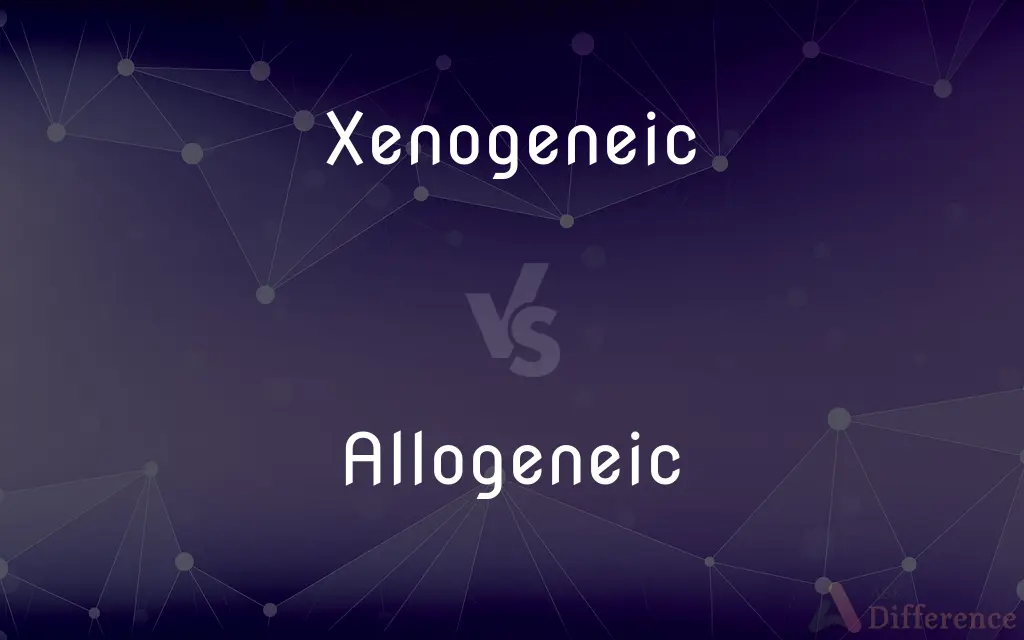Xenogeneic vs. Allogeneic — What's the Difference?
By Fiza Rafique & Maham Liaqat — Updated on April 24, 2024
Xenogeneic grafts come from different species, such as pig heart valves for humans, while allogeneic grafts involve donors and recipients from the same species but genetically different.

Difference Between Xenogeneic and Allogeneic
Table of Contents
ADVERTISEMENT
Key Differences
Xenogeneic grafts are sourced from different species, used in settings where human-compatible tissue is unavailable or unsuitable. On the other hand, allogeneic grafts are taken from a donor within the same species, ensuring a closer biological match. This fundamental distinction impacts the applications and potential for immune rejection in transplant medicine.
In xenogeneic transplantation, the immune response can be severe due to significant biological differences. Whereas, in allogeneic transplantation, the immune reaction, while still present, is generally less intense because of the closer genetic similarities between donor and recipient.
Xenogeneic grafts often require more intensive immunosuppression to prevent rejection. Conversely, allogeneic grafts may need less immunosuppression, reflecting the lesser degree of immunological disparity.
Xenogeneic transplants are considered in scenarios where there is a scarcity of human donors, providing an alternative to overcome donor shortages. In contrast, allogeneic transplants are more common and often preferred when human donors are available.
The regulatory and ethical considerations for xenogeneic transplants are more complex due to the use of animal tissues. In contrast, allogeneic transplants primarily navigate the ethical landscape of human-to-human donation.
ADVERTISEMENT
Comparison Chart
Source
Different species (e.g., pigs to humans)
Same species, different individuals
Immune Rejection
High risk, severe immune response
Lower risk, moderate immune response
Immunosuppression
Requires intensive immunosuppression
Requires moderate immunosuppression
Common Use
Used in cases of donor shortages
Preferred when human donors are available
Ethical Considerations
Complex, involves use of animal tissues
Less complex, involves human donors
Compare with Definitions
Xenogeneic
Relating to a transplant or graft from a different species.
The xenogeneic graft from a pig was used to repair the damaged heart tissue.
Allogeneic
Relating to cells, tissues, or organs transplanted between genetically distinct individuals of the same species.
Allogeneic bone marrow transplants are common for treating certain leukemias.
Xenogeneic
Involving a biological interaction between different species.
Xenogeneic interactions are studied to understand cross-species disease transmission.
Allogeneic
Pertaining to a graft involving a donor and recipient from the same species.
The allogeneic skin graft helped treat the burn victim.
Xenogeneic
A term used in immunology to describe antigens from another species.
Xenogeneic antigens can trigger a strong immune response in a recipient.
Allogeneic
Involving a transfer that does not have a genetic match as perfect as autologous transfers.
Allogeneic transfusions are carefully monitored to prevent immune reactions.
Xenogeneic
Pertaining to or derived from different species.
Xenogeneic tissues, like pig heart valves, are sometimes used in human surgeries.
Allogeneic
In immunology, referring to antigens in a transplant from a donor within the same species.
Allogeneic transplants still pose a risk of rejection due to non-matching antigens.
Xenogeneic
Related to genetic materials or cells from different species used in medical research.
Scientists use xenogeneic cells in cancer research to develop new treatments.
Allogeneic
Used in medical contexts to discuss donor compatibility issues.
Allogeneic transplants require careful matching of donor and recipient HLA types.
Xenogeneic
Derived or obtained from an organism of a different species
Xenogeneic tissue graft.
Xenogeneic antibodies.
Allogeneic
Being genetically different although belonging to or obtained from the same species
Allogeneic tissue grafts.
Xenogeneic
(genetics) Derived from a different species and therefore genetically and immunologically incompatible
Allogeneic
(genetics) Genetically different because of being derived from separate individuals of the same species.
Allogeneic
(immunology) Of a reaction that occurs when cells are transplanted into a genetically different recipient.
Common Curiosities
Why are xenogeneic transplants less common than allogeneic?
Due to higher risks of severe immune responses and complex ethical issues involving the use of animal tissues.
What does allogeneic mean?
Allogeneic refers to tissues or cells transplanted between different individuals of the same species.
What does xenogeneic mean?
Xenogeneic refers to tissues or cells that come from a different species.
Are xenogeneic transplants ethically controversial?
Yes, due to concerns about animal welfare and the implications of using animal organs in humans.
What are the main risks associated with allogeneic transplantation?
Immune rejection and the need for immunosuppression, though generally less severe than xenogeneic.
What is a typical use case for allogeneic transplants?
Treating diseases like leukemia with bone marrow transplants from a human donor.
Can xenogeneic tissues be used for any type of transplant?
They are typically used in specific cases where human tissues are not available or suitable.
What role does species difference play in xenogeneic immune responses?
Significant species differences lead to stronger and more complex immune reactions against the transplant.
What are the benefits of allogeneic over xenogeneic transplants?
Closer genetic matching, less intense immunosuppression, and broader acceptability.
How do doctors minimize rejection in xenogeneic transplants?
Through intensive immunosuppressive therapies and sometimes genetic modification of donor tissues.
What research is being done to improve xenogeneic transplant outcomes?
Research focuses on genetic engineering and better immunosuppressants to reduce rejection rates.
How is patient consent obtained for allogeneic transplants?
Through detailed discussion of risks, benefits, and alternatives, ensuring informed patient decisions.
What is immunosuppression, and why is it important in allogeneic transplants?
It involves using medication to reduce the immune system's response to prevent transplant rejection.
How do regulatory bodies impact allogeneic transplant procedures?
They ensure ethical practices and donor compatibility to minimize health risks.
How does immune system compatibility affect transplant success?
Better compatibility reduces the risk of rejection and the need for long-term immunosuppression.
Share Your Discovery

Previous Comparison
Initialled vs. Initialed
Next Comparison
Disinvite vs. UninviteAuthor Spotlight
Written by
Fiza RafiqueFiza Rafique is a skilled content writer at AskDifference.com, where she meticulously refines and enhances written pieces. Drawing from her vast editorial expertise, Fiza ensures clarity, accuracy, and precision in every article. Passionate about language, she continually seeks to elevate the quality of content for readers worldwide.
Co-written by
Maham Liaqat












































